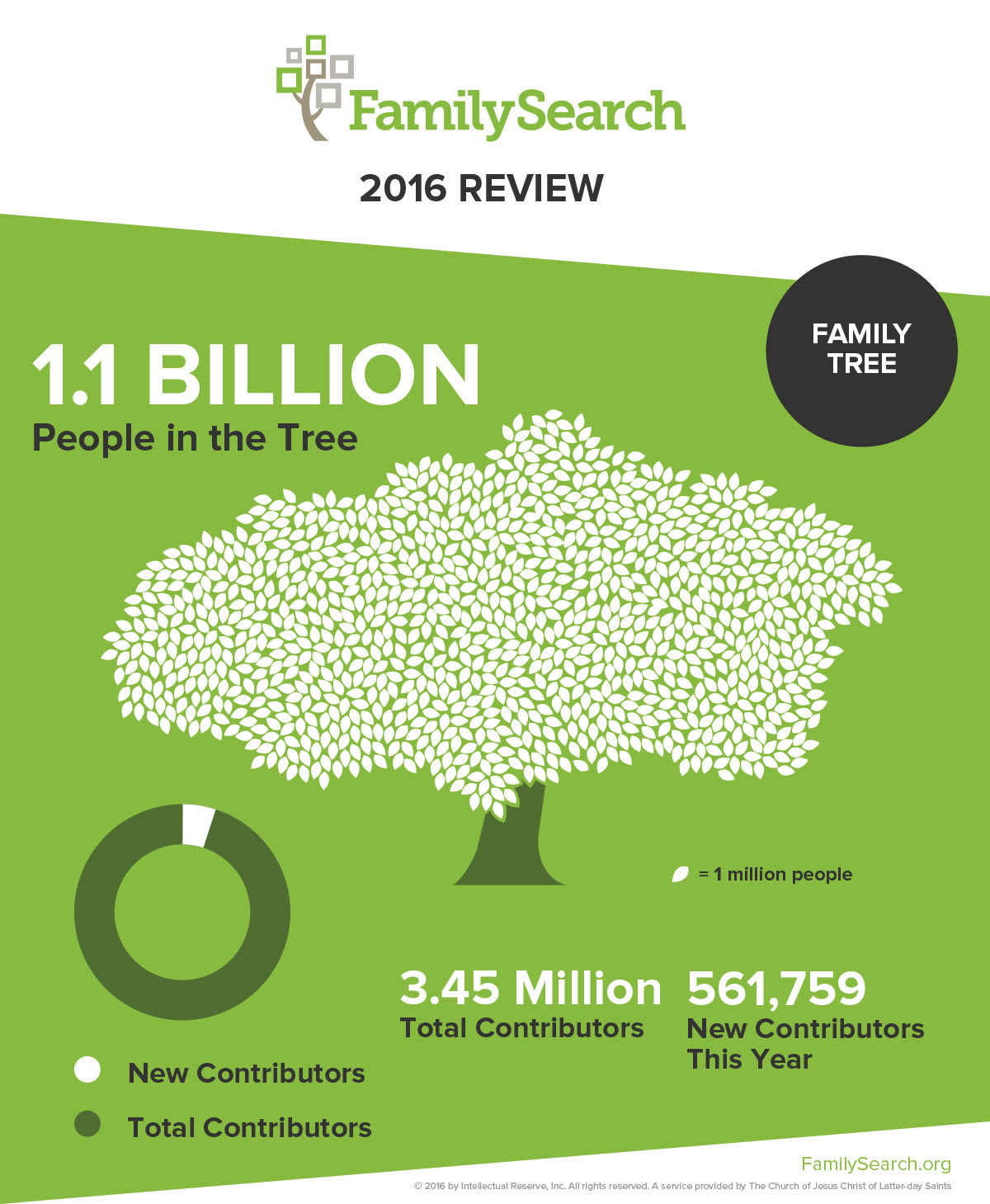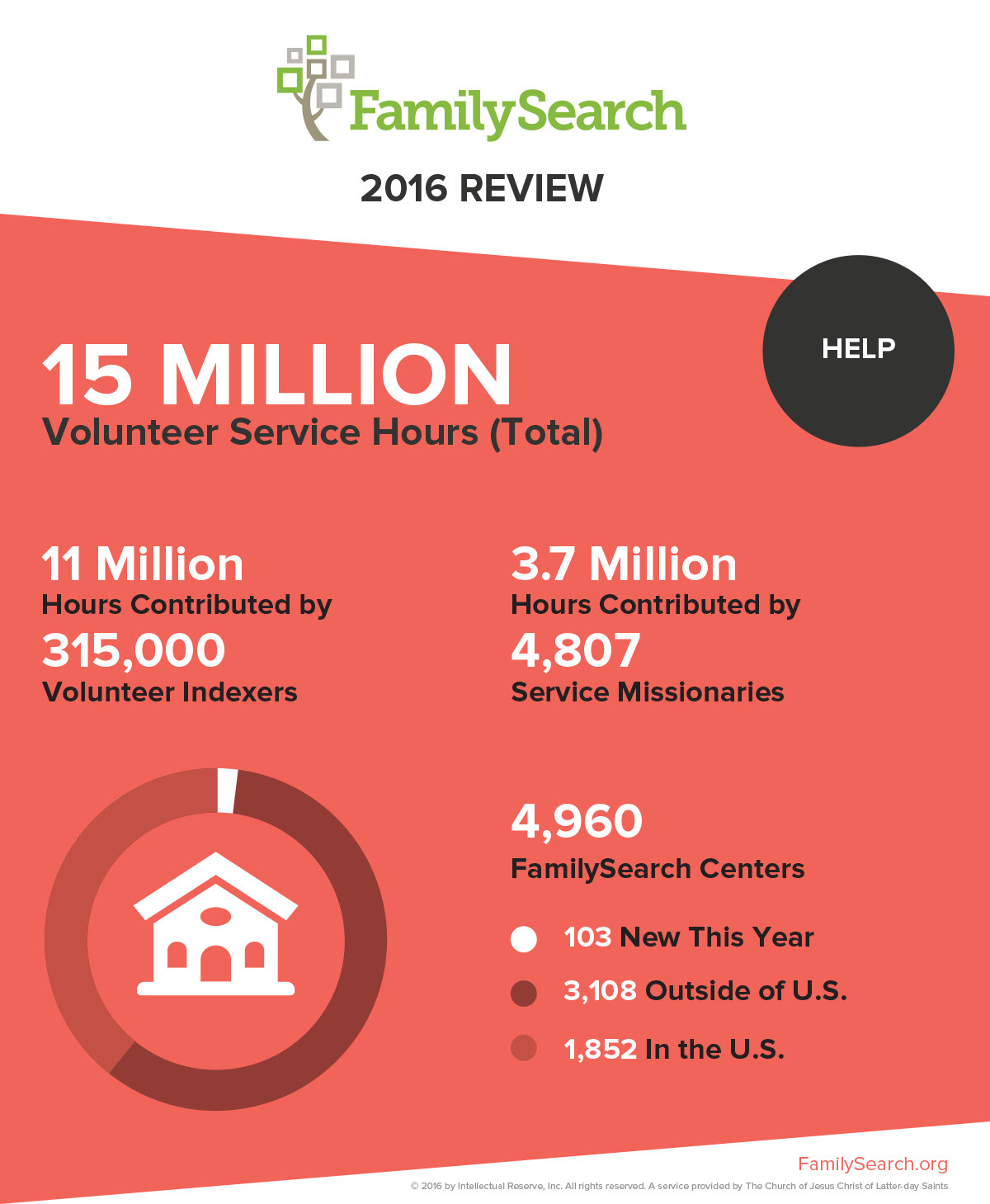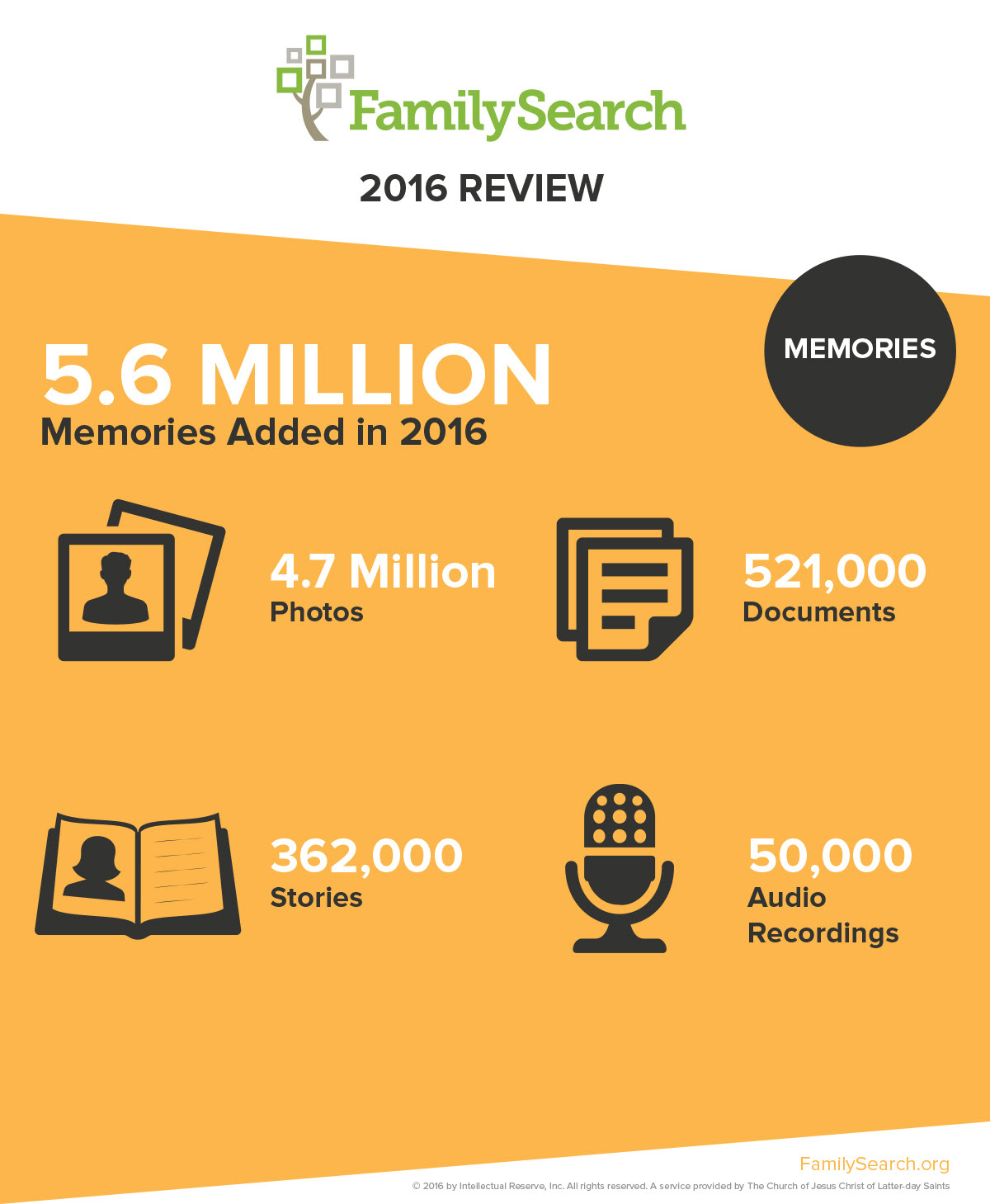FamilySearch 2016 Genealogy Highlights: FamilySearch has released its year-end summary of genealogy highlights looking back in 2016, all of which are focused on its mission to help connect families across generations.

FamilySearch 2016 Genealogy Highlights
SALT LAKE CITY (December 28, 2016)--Did you make a genealogy discovery online in 2016? Then you are most likely the beneficiary of the efforts of FamilySearch International, a leader in providing free, global family history services. FamilySearch has released a 2016 year-end summary highlighting some of its efforts to connect families across generations.
FamilySearch has completed extensive system upgrades on FamilySearch.org, making the free website more robust and much faster. Hundreds of millions of new historical records have been added. Improved search capabilities provide less duplication, better search results, and more insights at a glance across the multitude of various record types on FamilySearch.org. The ability to collaborate with other family members has been simplified and improved.
 Family Tree Upgrades
Family Tree UpgradesFamilySearch’s Family Tree is based on collaboration. In 2016, more than 561,000 new contributors added information to Family Tree, making a total of 3.45 million contributions. Now 1.1 billion individuals are linked in the FamilySearch Family Tree
Family Tree’s new user-to-user messaging feature simplifies collaboration with others doing research on common ancestors..
In the past, the community family tree had limitations in merging duplicate records contributed by users. System upgrades now enable users to merge duplicate records of large or highly common family lines.
 Access Increased to Historical Records
Access Increased to Historical RecordsFamily history discoveries are fueled by a person’s ability to easily and quickly search for ancestors by name in historical records online. In 2016, FamilySearch's online indexing initiative celebrated its 10th anniversary. FamilySearch has a dedicated team of employees and overwhelming online support from volunteers around the world who use FamilySearch’s technology to digitize and index the world’s historical records. As a result of these efforts, more than 5.57 billion searchable names are available from over 1.2 billion published searchable historical documents.
In conjunction with the Smithsonian National Museum of African American History and Culture and other organizations, FamilySearch completed a project to index and publish online images of Freedmen’s Bureau records from the United States National Archives and Records Administration.
 These
records are pivotal for African American research because they document
freed slaves and others who struggled to redefine themselves after the
Civil War. Nearly 19,000 online volunteers—mostly from the United States
and Canada—finished indexing the nearly two million handwritten records
in June 2016—just a year and a day after the initiative started. A copy
of the database was presented to the newly completed Smithsonian
National Museum of African American History Culture on December 6 of
this year. The digitized records are searchable on DiscoverFreedmen.org and Fa
These
records are pivotal for African American research because they document
freed slaves and others who struggled to redefine themselves after the
Civil War. Nearly 19,000 online volunteers—mostly from the United States
and Canada—finished indexing the nearly two million handwritten records
in June 2016—just a year and a day after the initiative started. A copy
of the database was presented to the newly completed Smithsonian
National Museum of African American History Culture on December 6 of
this year. The digitized records are searchable on DiscoverFreedmen.org and FaReceiving and Giving Help

 During
2016, 4,807 volunteer FamilySearch missionaries helped support
worldwide operation needs. These generous volunteers donated a
staggering 3.8 million hours of service. Non-missionary online
volunteers are also critical to indexing initiatives. Nearly 315,000
volunteers logged nearly 11 million hours during the year. Together
these two groups indexed 274.8 million records in 2016, bringing the
total number of indexed records freely searchable online to 2.4 billion.
Over 36 million of those newly-indexed records were in languages other
than English, bringing the total of non-English indexed records to 872
million.
During
2016, 4,807 volunteer FamilySearch missionaries helped support
worldwide operation needs. These generous volunteers donated a
staggering 3.8 million hours of service. Non-missionary online
volunteers are also critical to indexing initiatives. Nearly 315,000
volunteers logged nearly 11 million hours during the year. Together
these two groups indexed 274.8 million records in 2016, bringing the
total number of indexed records freely searchable online to 2.4 billion.
Over 36 million of those newly-indexed records were in languages other
than English, bringing the total of non-English indexed records to 872
million.FamilySearch’s 320 camera teams around the world digitally preserved over 60 million new images of historical records in 45 countries, providing more opportunities for online volunteer indexers to help make searchable records and countless more fun, family history discoveries waiting for FamilySearch.org users. FamilySearch.org added 125 new historical collections in 2016, bringing the total to 2,174.
In 2016, FamilySearch added a Help Others feature for volunteers who provide family history research or support assistance to others. To use the feature, a person seeking help provides his or her FamilySearch username and a unique helper number. The helper number allows a selected helper to remotely access the patron’s Family Tree online to provide research assistance.
Dozens of free video courses were added online during the year. These courses are accessible through the FamilySearch Learning Center. Over 100,000 helpful, how-to articles specific to family history are also now available through on the FamilySearch Wiki.
The dynamic records hints feature on FamilySearch.org is faster and more accurate, and it includes online collections and additional record types. Adding family photos, stories, documents, and audio files has become easier and is now mobile device friendly. Patrons can also identify their relationships to people in the Family Tree using a new relationship feature.
During the year, a new discovery center was opened in Layton, Utah, and construction on a similar facility began in St. George, Utah.
In addition to in-person visitors to the 4,960 FamilySearch family history centers worldwide in 2016, FamilySearch.org received 133 million online visits and reached 7.3 million registered users.
 Reaching Out to Others
Reaching Out to OthersLast January in Salt Lake City, Utah, FamilySearch hosted RootsTech 2016, the largest family history technology conference. The annual extravaganza included technology education and fun experiences to expand family connections. It attracted a record 375,000 attendees in person, online, and through local family discovery day events that took place across the world throughout the year. Special guests included bestselling author and New York Times columnist Bruce Feiler, producer and writer Paula Williams Madison, StoryCorps founder David Isay, and America’s historian-in-chief, Doris Kearns Goodwin.
 Memories—The Crown of Family History
Memories—The Crown of Family History“Family history is about stories; it is more than dates and facts,” says Steve Rockwood, president and CEO of FamilySearch, looking back on FamilySearch’s efforts in 2016. “People of every age, locale, and heritage share a universal need to know where they come from. These connections are not just about the names, dates, and places—although that certainly helps to know where someone fits in our family trees—but the fun, inspiring, real stories of those ancestors who came before us. FamilySearch is resolute in creating the tools and services people need worldwide to discover those joyful connections and share them."
FamilySearch has incorporated innovative technology and initiatives that engage a broadening swath of consumers to experience emotional, endearing experiences with their family and family history.
FamilySearch’s free mobile apps—Family Tree and Memories—now enable users to freely attach and save photos and stories (audio and text) to individuals in the FamilySearch Family Tree, add other information, and receive notifications when others add content to the records of shared ancestors. Users can easily add photos, stories, and scanned documents and sort their uploaded memories collections.
Users can now record stories of relatives with a new mobile audio recording feature and save the audio files directly to the memories gallery on FamilySearch.org from a mobile device. The memories feature now includes contributor information so participants can message each other. The Details section is another innovative tool of the mobile FamilyTree app. With it you can see information, images, documents, and sources by simply swiping the screen, and the application creates a map of locations where events took place in the life of a person as recorded on FamilySearch Family Tree.
Explore these and other new developments at FamilySearch.org.
Find and share this news release in the FamilySearch Media Room.
###
About FamilySearchFamilySearch International is the largest genealogy organization in the world. FamilySearch is a nonprofit, volunteer-driven organization sponsored by The Church of Jesus Christ of Latter-day Saints. Millions of people use FamilySearch records, resources, and services to learn more about their family history. To help in this great pursuit, FamilySearch and its predecessors have been actively gathering, preserving, and sharing genealogical records worldwide for over 100 years. Patrons may access FamilySearch services and resources free online at FamilySearch.org or through over 4,921 family history centers in 129 countries, including the main Family History Library in Salt Lake City, Utah.














